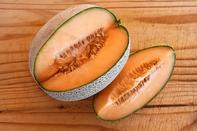
Scientific name: Cucumis melo
Common Name: Cantaloupe, Melon, Sweet melon, Musk melon or Spanspek
The Cantaloupe plant is said to have originated in the South West of Asia where it was first called a Musk Melon because of its delicious smell when ripe. The fruit was later introduced into Europe and named after a town in Italy called Cantalupo where it was planted after seeds were introduced from Armenia in the Persian Empire.
There is an interesting story behind what some believe to be the origin of the Afrikaans name for cantaloupe, spanspek. It is said to originate from Spaanse spek meaning Spanish bacon.
Lady Juana Maria Smith, the Spanish wife of Sir Henry (Harry) Smith (he preferred to be called Harry), a Governor in the Cape Colony in the mid 1800’s, preferred Cantaloupe or Musk Melon for her breakfast while her husband preferred eggs and bacon. Because of her Spanish heritage this unusual choice was termed her “Spanish bacon” breakfast by their staff.
Cantaloupe Plant Description
The cantaloupe is part of the cucurbit family. Cantaloupes grow on a vine that has tendrils which spread across the ground. The vine can be trellised for the smaller melon varieties.
The plant has an extensive shallow root system that can spread throughout the area covered by the leaves and vines. It has a supporting tap root that descends to about 30 to 40 cm.
It is therefore important to control weeds and irrigate regularly as most of the roots are in the top 20 cm of soil.
Uses of Cantaloupe
Cantaloupe is a fruit that is eaten fresh on its own. It can also be juiced or combined with other fruit in fruit salad and as a dessert. Some varieties are also sometimes dried.Soil Requirements and Preparation
Always have your soil analysed before preparation to ensure that all the required macro and micro nutrient deficiencies that exist in the soil can be addressed before planting. Cantaloupe does best on sandy loam to slightly loam soils. High clay content hampers root development and drainage.
Soil pH should be between 6.0 and 7. About eight weeks before planting apply the required phosphates and lime to adjust pH and organic material like compost or manure, then deep plough the land to about 60 cm.
About two weeks before planting prepare the top soil seedbed. This is done by disk harrow or rotavator to break up the soil sods and remove any weeds that have started to grow.
If planting is to be on raised seed beds or ridges these should be also prepared two weeks prior to planting. If drip irrigation is to be installed this should also done at this point and if plastic mulching is used this is laid out over the ridges at this stage.
Climate
Cantaloupes like a warm climate and do best when daytime temperature range between 20°C to 30°C and when nights temperatures below 15°C are rare. Growth slows drastically if temperature drop closer to 10°C.
Below 10°C the development of the fruit is adversely affected and results in loss of production. The plant is frost sensitive and young plants can be killed by it. Rain during the latter part of the growth period also adversely affects the fruits storage ability. Rain also promotes fungus growth.
Cantaloupe Cultivars
Honeydew, Galia, Hales Best, Piel de Sapo, Imperial, Edisto, Eastern Shipper, Majestic, Charentais, Fargo and Caribbean King are some of the varieties and there are many more.
For the best variety for your area of production it is best to get advice from your extension officer or local seed specialist.
By Louise Brodie